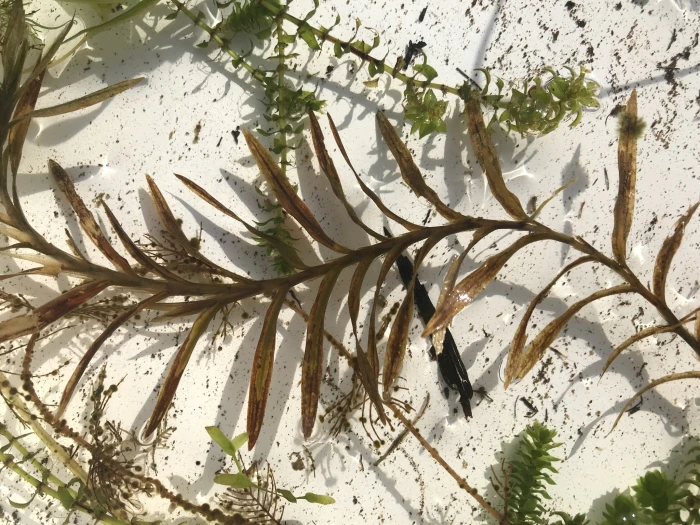Robbins’ Pondweed
(Potamogeton robbinsii)
Robbins’ Pondweed (Potamogeton robbinsii)
/
/

David McCorquodale
CC BY 4.0
Image By:
David McCorquodale
Recorded By:
Copyright:
CC BY 4.0
Copyright Notice:
Photo by: David McCorquodale | License Type: CC BY 4.0 | License URL: http://creativecommons.org/licenses/by/4.0/ | Rights Holder: David McCorquodale | Publisher: iNaturalist | Date Created: 2019-08-26T21:19:57Z |

























Estimated Native Range
Climate Requirements for Midlothian, Texas
| This Plant | Your Site | Plant Suitability for Your Location | ||
|---|---|---|---|---|
| • Precipitation | 44" - 66" | 36" | Aquatic | Aquatic |
| • High Temp. | 73°F - 82°F | 95°F | Your summers may be too hot for this plant. | Too hot |
| • Low Temp. | -5°F - 22°F | 34°F | Your winter temperatures are normal for this plant | Excellent |
This plant should grow well at your location with about N inches per year (Y minutes per month) of irrigation.
Summary
Potamogeton robbinsii, commonly known as Robbins’ pondweed, is a perennial aquatic herb native to North America, specifically thriving in the still or slow-moving waters of lakes, ponds, and rivers. It is often found in freshwater environments that can range from clear to turbid and from oligotrophic to eutrophic conditions. This species prefers soft, muddy substrates where it can root effectively. Robbins’ pondweed can grow in water depths from shallow to relatively deep, adapting to a variety of aquatic habitats.
Robbins’ pondweed is characterized by its elongated, linear leaves that are densely packed along the stem, providing a lush underwater foliage that is beneficial for aquatic ecosystems. The leaves are stiff with minutely serrated margins, and the plant produces inflorescences with one to twenty-six straight peduncles, each bearing a spike of flowers. The flowers are small and not particularly showy, blooming from August to September. While not a traditional ornamental plant, Robbins’ pondweed plays a crucial role in aquatic environments by oxygenating the water and providing habitat for fish and invertebrates. It is also used in water gardens and for natural water filtration in constructed wetlands. In cultivation, it requires an aquatic setting with full sun to part shade and can tolerate a range of water conditions, from clear to turbid. There are no popular garden cultivars of this species, as it is primarily valued for its ecological functions rather than ornamental qualities. Potential problems include susceptibility to water pollution and displacement by invasive aquatic species.CC BY-SA 4.0
Robbins’ pondweed is characterized by its elongated, linear leaves that are densely packed along the stem, providing a lush underwater foliage that is beneficial for aquatic ecosystems. The leaves are stiff with minutely serrated margins, and the plant produces inflorescences with one to twenty-six straight peduncles, each bearing a spike of flowers. The flowers are small and not particularly showy, blooming from August to September. While not a traditional ornamental plant, Robbins’ pondweed plays a crucial role in aquatic environments by oxygenating the water and providing habitat for fish and invertebrates. It is also used in water gardens and for natural water filtration in constructed wetlands. In cultivation, it requires an aquatic setting with full sun to part shade and can tolerate a range of water conditions, from clear to turbid. There are no popular garden cultivars of this species, as it is primarily valued for its ecological functions rather than ornamental qualities. Potential problems include susceptibility to water pollution and displacement by invasive aquatic species.CC BY-SA 4.0
Plant Description
- Plant Type: Herb
- Height: 1-3 feet
- Width: 1-3 feet
- Growth Rate: Rapid
- Flower Color: Green
- Flowering Season: Summer, Fall
- Leaf Retention: Deciduous
Growth Requirements
- Sun: Full Sun, Part Shade
- Water: High
- Drainage: Standing
Common Uses
Low Maintenance, Water Garden
Natural Habitat
Thriving in still or slow-moving waters of lakes, ponds, and rivers, often in muddy substrates
Other Names
Common Names: Fern Pondweed
Scientific Names: Potamogeton robbinsii, Potamogeton robbinsii f. cultellatus, Potamogeton robbinsii f. robbinsii, Spirillus robbinsii
GBIF Accepted Name: Potamogeton robbinsii